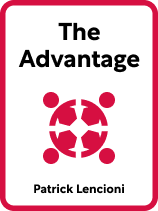

This article is an excerpt from the Shortform book guide to "The Advantage" by Patrick Lencioni. Shortform has the world's best summaries and analyses of books you should be reading.
Like this article? Sign up for a free trial here.
What makes a productive business? How do you create a hard-working team?
According to Patrick Lencioni in his book The Advantage, a productive business is one where the goals of the company are clear and communicated to everyone on the team. In addition, everyone within the company is dedicated to achieving these goals.
To learn how to create a productive business that’s efficient, continue reading.
How Do You Create a Productive Business?
Lencioni’s process to achieve organizational health and a productive business can be broken into four main steps:
- Create a unified and efficient leadership team that runs the organization.
- Establish clear and consistent organizational goals and standards.
- Achieve employee alignment with and dedication to the organization’s goals and standards.
- Maintain organizational health by having effective meetings.
Step #1: Create a Unified and Effective Leadership Team
Lencioni explains that a productive business starts at the top, so you must begin by creating a unified and efficient leadership team. This team should ideally be composed of three to nine individuals who’ll share responsibility for establishing and achieving organizational goals. Each of these individuals should represent a crucial part of the organization or provide a unique, valuable perspective to the team. The team should be able to come to collective decisions after meaningful discussions and debates.
(Shortform note: The importance of effective leadership teams and the characteristics they must have—like safety, accountability, and specialized roles—are widely accepted among business experts. However, the ideal size of an effective team has been widely debated and studied for years before and after the publication of The Advantage. In recent years, experts have generally come to the agreement that smaller is better—small teams make more effective decisions at a more efficient pace. While the ideal number of members will depend on factors like the size of your organization, the general consensus is that the maximum number of members should be seven—two less than Lencioni’s suggestion of nine.)
To create a unified and effective leadership team, Lencioni explains that the team must establish five standards: safety, advocacy and debate, unanimous dedication, specialized roles, and the ability to hold each other responsible. Let’s explore each standard in detail.
Step #2: Establish Clear and Consistent Organizational Goals and Standards
Next, Lencioni says that leadership teams must create a company culture with clear and consistent organizational goals and standards. These goals and standards will provide employees with clarity on the organization’s purpose and their role in it and will unify them through shared values and ideals.
To create a company culture with clear and consistent goals and standards, Lencioni says the leadership team must establish four principles: the organization’s core purpose, its behavioral values, its strategies for success, and its top priority.
(Shortform note: In The Culture Code, Daniel Coyle similarly emphasizes the importance of a strong company culture with clear and consistent goals and standards. However, rather than the organization’s purpose being one component of a strong organizational culture, he says purpose is the foundation of other cultural elements, like behavioral values, success strategies, and priorities. He elaborates that putting purpose at the core of the organization will increase the energy employees put towards tasks, make people learn faster, and increase connection and empathy among coworkers and customers. Ultimately, these benefits will maximize the organization’s success.)
Step #3: Achieve Employee Alignment and Dedication
For a business to be productive, Lencioni says that employees must align with and be dedicated to the organization’s goals and standards—this is vital for organizational unity.
To achieve employee alignment, the organization’s hiring and firing processes must align with its goals and standards. To achieve employee dedication, leaders must constantly and effectively communicate the organization’s goals and standards and their personal dedication to them. Let’s explore each of these processes in more detail.
(Shortform note: To create employee alignment and dedication, Lencioni says goals and standards must be prioritized during hiring and firing and must be constantly communicated to employees. While John Doerr agrees that goals must be transparent, he points out in Measure What Matters that creating organizational goals and standards at the top, as Lencioni recommends, may disrupt employee dedication. When goals and standards are created at the top and then trickled down through methods like hiring processes and rigid protocols, employees on the ground aren’t given the opportunity to offer ideas regarding their own work. Consequently, they may feel like their opinions and experiences aren’t valued, and organizational efficiency, flexibility, connection, and motivation may decrease as a result.)
Step #4: Maintain Organizational Health With Effective Meetings
Finally, Lencioni explains that you must maintain organizational health by having effective meetings. In these meetings, the organization’s values and success strategies must be used to solve problems, achieve goals, and progress the organization. To be effective, the meetings must have a clear, narrow focus.

———End of Preview———
Like what you just read? Read the rest of the world's best book summary and analysis of Patrick Lencioni's "The Advantage" at Shortform.
Here's what you'll find in our full The Advantage summary:
- How the biggest business advantage you can gain is free and within your reach
- How to create an effective leadership team
- How to maintain organizational health with effective meetings






